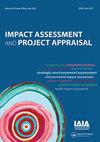Replacing EIA and SEA with Environmental Outcome Reports (EORs) - the 2022 levelling up and regeneration bill in the UK
IF 1.9
4区 社会学
Q3 ENVIRONMENTAL STUDIES
引用次数: 2
Abstract
Dear readers, In May 2022, the UK’s Johnson government published a ‘Levelling-up and Regeneration Bill’ (‘A Bill to make provision for the setting of levelling-up missions and reporting on progress in delivering them’), subsequently referred to as ‘the Bill’. Amongst other things, this aims at ‘reforming’ town planning in England (it is unclear whether it will also apply to Scotland, Wales and Northern Ireland). A key aim is to shorten planning consent procedures. If the Bill obtains Royal Assent in 2023 and becomes law, Environmental Impact Assessment (EIA) and Strategic Environmental Assessment (SEA) are foreseen to be replaced by socalled ‘Environmental Outcome Reports’ (EORs). Whilst to date, there have neither been any pilot studies of EORs nor indeed any discussion on them and their description in the Bill is rudimentary, the main rationale for their introduction is connected with a desire to simplify requirements for considering environmental impacts of plans, programmes and projects (PPPs), and to substantially reduce the effort and time currently going into the assessment of environmental impacts of PPPs. The idea behind EORs is to test whether a PPP is in line with defined environmental targets (to be prescribed by central government). Apart from a few PPPs to which the UNECE Convention on EIA in a Transboundary Context/the associated SEA Protocol may apply, it appears that EORs will not be the outcome of a comprehensive EIA/SEA type participative procedure. Rather, it seems that they are meant to be based on the completion of an assessment checklist or matrix, possibly similar to what e.g. a rapid health impact assessment (HIA; see Fischer et al. 2021) or a BREEAM (Building Research Establishment Environmental Assessment Method; Ewuosho 2014) assessment looks like, with an emphasis on the achievement of specific environmental targets. Public engagement can occur if the Secretary of State deems this necessary. There are undoubtedly a number of weaknesses of current EIA and SEA practices in the UK (with regards to England, see, e.g. Arts et al. 2012; Fischer 2010; Jha-Thakur and Fischer 2016) and there is clearly scope for improvement, in particular with regards to achieving greater substantive effectiveness (Fischer and Retief 2021). So whilst a greater focus on outcomes is not necessarily a bad thing, the implied anticipated approach of EORs raises some serious concerns. In this context, it is important that environmental assessments (EAs; encompassing both, EIA and SEA), introduced first in the US through the National Environmental Policy Act (NEPA) in 1970 and subsequently throughout the world, were deliberately designed as participatory ex-ante (i.e. prepared before the final design) assessment procedures (Fischer and González 2021a), mainly due to the failings of technical checklist/matrixbased impact analyses, in particular, cost-benefit analyses – CBA. In this context, a key challenge for many EAs is how to deal with trade-offs between different aspects and inflexible technical checklist/matrix-based approaches are illequipped to do so. Acknowledging the complex and often ‘wicked’ nature of human activity induced environmental impacts, EA is not just designed as a tool for environmental protection, but also as a platform for debate (O’Faircheallaigh 2010). In this connection, EA has been described by many commentators as a ‘science and an art’. Ultimately, participative EAs that are done well have shown to be able to effectively reduce opposition to plan, programme and project processes, thus reducing overall implementation times. This is achieved based on helping those potentially affected to develop an understanding of the type and scale of impact and allowing them to actively help shape mitigation (Fung 2020). Any non-participatory prescribed and inflexible checklist/matrix-based technical exercise runs the risk of ignoring concerns, as well as missing important aspects or putting the emphasis on the wrong aspects. Furthermore, a technical exercise which is done at one point in the PPP preparation process only is unable to pro-actively shape development in an ex-ante manner. In that regard, it is important that EAs are increasingly perceived not just as a one-off exercise applied to one specific PPP, but rather as a framework which supports a pro-active allocation of specific tasks to particular decision tiers (usually expressed in terms of policies, plans, programmes and projects) within a systematically organised decision system. This can lead to streamlined decision making by helping to address the right issues at the right time, thus avoiding duplication and delays. An associated theory of ‘selection logic’ was introduced by Fischer and González (2021b). The Bill itself is mainly concerned with an emphasis on speeding up project development and there is not much strategic thinking reflected in the desired ‘reformed’ approach to assessment. However, and importantly, most of the details of the Bill with regards to EORs are yet to be revealed. Questions to be addressed include whether thresholds for needing to prepare EORs will be lower than those in IMPACT ASSESSMENT AND PROJECT APPRAISAL 2022, VOL. 40, NO. 4, 267–268 https://doi.org/10.1080/14615517.2022.2089375用环境结果报告(EORs)取代环境影响评估(EIA)和环境影响评估(SEA)——英国2022年升级和再生法案
然而,重要的是,该法案关于EOR的大部分细节尚未披露。需要解决的问题包括需要准备EOR的阈值是否会低于《2022年影响评估和项目评估》第40卷第4期第267-268页中的阈值https://doi.org/10.1080/14615517.2022.2089375
本文章由计算机程序翻译,如有差异,请以英文原文为准。
求助全文
约1分钟内获得全文
求助全文
来源期刊

Impact Assessment and Project Appraisal
ENVIRONMENTAL STUDIES-
CiteScore
4.60
自引率
22.70%
发文量
52
期刊介绍:
This is the international, peer-reviewed journal of the International Association for Impact Assessment (IAIA). It covers environmental, social, health and other impact assessments, cost-benefit analysis, technology assessment, and other approaches to anticipating and managing impacts. It has readers in universities, government and public agencies, consultancies, NGOs and elsewhere in over 100 countries. It has editorials, main articles, book reviews, and a professional practice section.
 求助内容:
求助内容: 应助结果提醒方式:
应助结果提醒方式:


